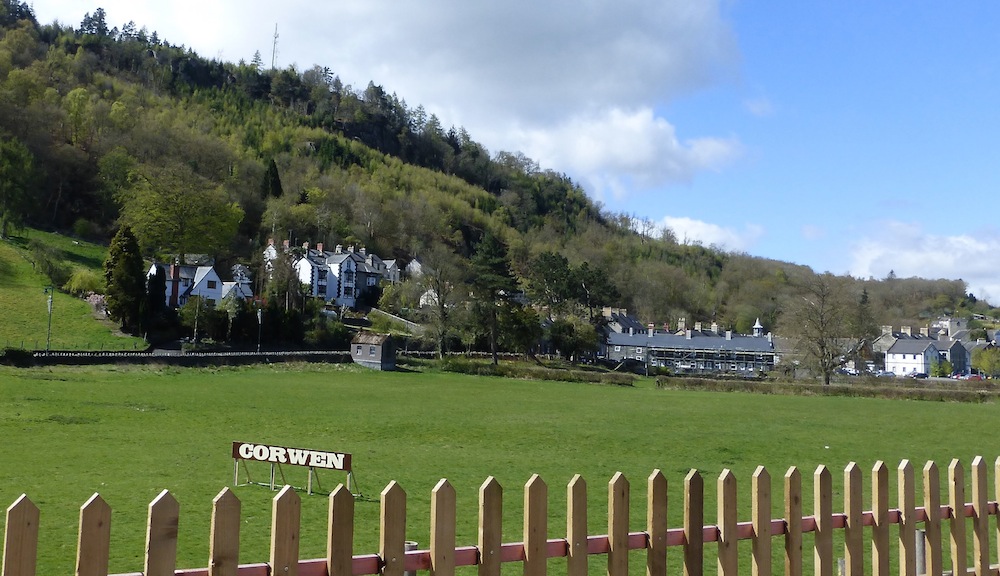All photographs are by the present author, except for the first one of Berwyn Station, taken by Meiron for the Geograph website. This is available for reuse under the Attribution-ShareAlike 2.0 Generic (CC BY-SA 2.0) license. You may use the others too without prior permission for any scholarly or educational purpose as long as you (1) credit the photographer and (2) link your document to this URL in a web document or cite The Victorian Web in a print one. Click on the images to enlarge them.
Berwyn and the River Dee


Left to right: (a) Berwyn Station on a ledge at the side of the King's Bridge. (b) The King's Bridge over the Dee Gorge at Berwyn.
The Llangollen to Corwen railway was constructed by Thomas Brassey under the direction of Henry Robertson in 1865. It follows the River Dee and after leaving Llangollen soon approaches the Dee Gorge and its bridges. This first station is dramatically perched on a ledge to the south, and is a Grade II listed building. Designed in 1864 by Samuel Pountney Smith, it is built in light-coloured brick "with applied black and white detail above ground floor to the W end," as the listing text says. It was built to match the Chainbridge Hotel [view from train] of 1828 on the opposite bank. The stationmaster's house is now let for holidays.
The road bridge across the Dee here is also Grade II listed. It was designed in 1901, and completed in 1906. According to its listing text,it is of "rock-faced rubble with arches turned in blue engineering brick," and was named in commemoration of King Edward VII's coronation.

Following the River Dee after this point.
Glyndyfrdwy Station and the South Barmouth Signal Box



Glyndyfrdwy Station. (a) View of the station house. (b) On the platform. (c) Re-sited South Barmouth signal box.
Glyndyfrdwy Station is the next stop on the line west. The late nineteenth-century stationmaster's house, right on the platform at the station, is also now used for holiday lets. Even in 2001, Jim Green found the station here "clean, tidy and well-presented, not in the least derelict or uncared for" (34), and now the enthusiasm that he commented on has produced a pleasant stop with facilities for refreshments and a children's play area (see "The Line"). The reopened Llangollen railway is part of an old line that used to run from Ruabon in Wrexham to Barmouth in Gwynned, so it is quite appropriate for the signal box to have been re-sited here.
Carrog Station



Carrog station buildings and platform (see both on the outward and return journeys) a composite work of restoration and recreation, with completely convincing results.



Left to right: (a) Inside the original booking hall, which has the original ticket office window. (b) Platform 2 Waiting Room, now serving as a small museum. (c) The Carrog signal box.
After the closer of this once-popular station, the main buildings were preserved as a council tenancy, and eventually sold to a member of the Llangollen Railway Trust at the end of the 1980s. These were then renovated. Some elements, however, had been demolished — this included the signal box, and the waiting-room on the return side which the GWR had added later. But in the end the whole station was recreated: "Complete buildings, and railway fittings were obtained from various locations in the UK and reconstructed at the station site. Replica items such as signs and lamps were made where correct originals were missing and substitutes could not be found" ("Carrog Station"). The station was reopened in 1996, looking very much as it did in the 1950s, before deterioration set in.
Corwen and Back


Left: Corwen, where the station rebuilding is still in progress. Right: Locomotive 3802 leaving Carrog for Llangollen on the return journey.
Related Material
Bibliography
"Berwyn Railway Station." British Listed Buildings. Web. 5 July 2017.
Dickinson, Peter. "Berwyn Station." Llangollen Railway. Web. 5 July 2017.
Green, Jim. Welsh Railways. Talybont, Ceridigion: 2001.
"The Line." Llangollen Railway. Web. 5 July 2017.
"A Short History of Carrog Station and the Barmouth Line." Carrog Station. Web. 6 July 2017.
Created 4 July 2017